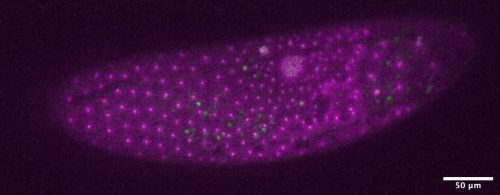Repulsive interactions bring rapid mitotic divisions to order
Posted by Ana Morais, on 26 January 2022
New research, published in Development, describes repulsive forces driving the uniform distribution of nuclei in the developing embryo. Study conducted at the Instituto Gulbenkian de Ciência (Ivo Telley & Jorge Carvalho) in collaboration with MBI Singapore (Tim E. Saunders).
The new study provides evidence for the biophysical principles that maintain the order of nuclei in fruit fly embryos. The team found that microtubules, protein polymers that are part of the cell skeleton, form a scaffold generating repulsive forces that keep nuclei at a distance. The positioning of nuclei inside multinucleated cells is very complex, encompassing a large array of possible interactions between neighboring nuclei. This type of cells develops “most robustly by an internuclear repulsion mechanism – which we present in our paper”, explains Ivo Telley, principal investigator at Instituto Gulbenkian de Ciência (IGC) and leader of the team that conducted the study. Besides maintaining nuclear positions, repulsive interactions can also reorient nuclear divisions towards unoccupied regions, where repulsion is weakest, avoiding an uneven distribution of nuclei inside large cells.

“Repulsion between nuclei was a hypothesis proposed more than twenty years ago but had never been supported by experiments”, Ivo remarks. This quest for one of “nature’s most basic principles” started in 2013 and involved collaboration with research institutes in Singapore and Germany. Soon after Ivo set up his lab at the IGC, Jorge Carvalho, first author of the study, joined him to implement the innovative experimental approach that would lead to these findings. Fruit fly embryo explants, made by extracting cytoplasm and nuclei from the embryo, allowed the researchers to unveil the mechanisms behind nuclei distribution without the need to use living samples, which are often complex and difficult to analyze. “This approach was key to most of the experimental data in the paper”, Jorge emphasized.
Ultimately, this long journey led the researchers to discover a mechanism that directly impacts cell size and positioning, two properties that define core cellular functions in later embryonic development. But these findings go beyond the development of insects: they also improve our understanding of the evolution of species, such as our own. “Internuclear repulsion was key for the transition from unicellular organisms to multicellularity”, Ivo highlights.


 (1 votes)
(1 votes)